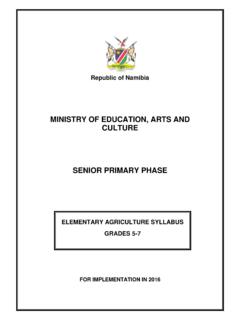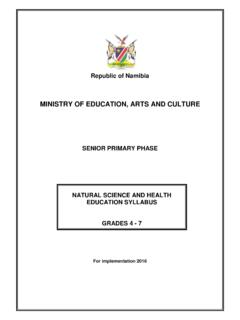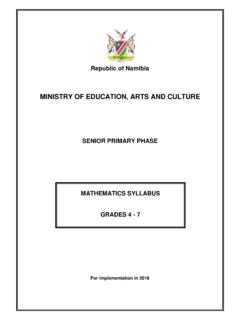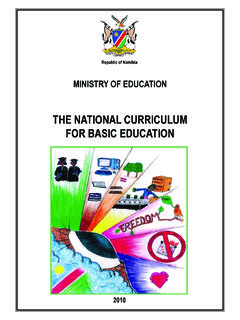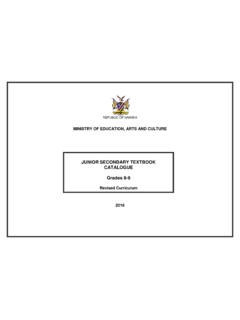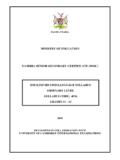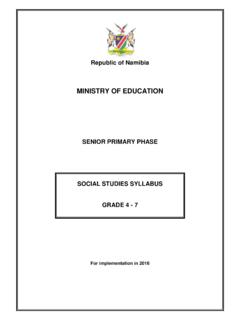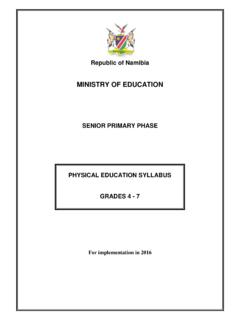Transcription of MINISTRY OF EDUCATION, ARTS AND CULTURE
1 republic of namibia MINISTRY OF education , arts AND CULTURE SENIOR PRIMARY PHASE To be implemented in 2016 ENGLISH SECOND LANGUAGE SYLLABUS GRADES 4-7 MINISTRY of education , arts and CULTURE National Institute for Educational Development (NIED) Private Bag 2034 Okahandja namibia Copyright NIED, MINISTRY of education , arts and CULTURE 2015 English Second Language Syllabus Grades 4 - 7 ISBN: 978 99945-2 101-2 Printed by NIED Website: Publication date: December 2015 TABLE OF CONTENTS 1. Introduction ..1 2. Rationale ..1 3. Aims ..2 4. Inclusive education ..2 5. Links to Other Subjects and Cross-curricular Issues.
2 3 6. Approach to Teaching and 7. End of phase competencies ..5 8. Summary of the Learning Content ..6 9. Learning 10. Assessment .. 69 Continuous Assessment .. 62 Formative and summative assessment .. 62 Informal and formal methods .. 62 Evaluation .. 63 Criterion-refenced grades .. 63 Grade 63 Conducting and recording assessment .. 64 Assessment Objectives .. 64 Continuous assessment: Detailed guidelines .. 64 End-of-year examination .. 68 11. Appendices .. 71 Appendix 1: Glossary .. 71 Appendix 2: Expressions used in conversational English.
3 72 Appendix 3: Assessment of Speaking .. 74 Appendix 4: Assessment of 75 Appendix 5: Reading Aloud Assessment Criteria .. 76 Appendix 6: Marking Grid for shorter writing 77 Appendix 7: Marking Grid for Composition .. 78 Appendix 8: Reading Continuous assessment record English Second Language syllabus Grades 4-7, NIED 2015 1 1. Introduction This syllabus describes the intended learning and assessment for English Second Language in the upper primary phase. As a subject, English Second Language falls within the language area of learning in the curriculum, but has thematic links to other subjects across the curriculum.
4 2. Rationale In the Namibian curriculum, English has a dual purpose as a subject taught from Grades 1 to 12 and a medium of instruction from Grades 4 to 12. As such, English plays a key role within the Namibian context. Being the official national language of namibia , English occupies an important position in our citizens lives. By virtue of it being the one language all Namibian learners will study, English operates as an important language of national unity and identity. In the wider sphere it is an access language to the international community and the worldwide information network. This is reflected in the position of English as one of the compulsory subjects in the curriculum.
5 Through the curriculum and the efforts of teachers, the Namibian education system must meet its constitutional obligation to ensure proficiency in the official language . By the end of the Senior Primary Phase, learners should have developed the English language literacy and communication competency that forms the basis for lifelong learning. English has the same potential as any other language to act as a catalyst of personal growth and to assist in the development of broad general knowledge, positive attitudes, critical thinking abilities, moral values and the aesthetic sensibilities. This potential is enhanced by the rich and varied literary and scholarly heritage that is a part of the English language.
6 English has an interdisciplinary role in supporting learning across the curriculum. As English is the medium of instruction, conscious attention to language will be the concern of all teachers, not only English teachers. English teachers, however, have a special responsibility to assist their colleagues and learners so that they are able to use the language effectively in all subjects. The particular features of English Second Language in this phase are that: through wide experience of and exposure to English, learners will become increasingly aware of correct and meaningful language and correct uses of grammatical structures.
7 It is important that all four language skills, including literature and language usage are integrated during teaching and learning, in order to maximise growth and development in the language. language under-grids the entire curriculum: the stories that learners read and listen to, the topics they deliberate on, the role plays they perform, will all have cross-curricular links with issues such as the environment, health (HIV and AIDS), information and technology, human rights, the rights of children, personal and community values including gender, social justice and democracy. They will learn to understand and deal with these issues and develop values as they read, talk and write about them.
8 English Second Language syllabus Grades 4-7, NIED 2015 2 3. Aims The overall aim of teaching English as a second language is the development of the learners communicative skills for meaningful interaction in a multi-lingual and multi-cultural society. English Second Language promotes general and specific aims in the curriculum: The syllabus promotes the following general aims: to support creativity and intellectual development to help learners develop self-confidence and a better understanding of the world in which they live to develop positive attitudes, values and an understanding of local, social and cultural issues to develop greater awareness of health and population issues, democracy and human rights, information and technology, HIV and AIDS, the environment and individual responsibilities regarding these and to enable learners to talk, read and write about them The syllabus promotes the following specific aims.
9 To enable learners to communicate effectively in speech and writing in their second language to enable learners to express thoughts, ideas, experiences and values as an essential part of personal development to develop proficiency in the medium of instruction 4. Inclusive education Ideally, learners with impairments get accommodated in special schools or classes. However, due to the scarcity of special schools/classes in namibia , many learners with visual-, hearing impairments and learning difficulties end up in mainstream schools. As English Second Language teachers, you should try to understand that learning impairment affects the way that an individual takes in, retains, or expresses information.
10 Different types of learning impairments can impact spoken or written language, spelling, organisational skills and memory, among others. Nonetheless, it is imperative that English Second Language teachers should uphold the same high standards for a learner with visual or hearing impairments and or learning difficulties as would for all of the learners in the class. Schools do not serve a learner with visual or hearing impairments and or learning difficulties well by lowering expectations, but rather by understanding the impairment as an aspect of such a learner s identity. The child with any form of impairment is above all a learner and in recognising this, English Second Language teachers should ask not whether one can teach such a learner, but how to assist and support him or her to learn.
